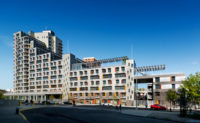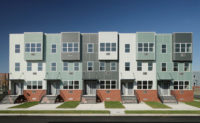It’s no surprise that, when New York chose to build a garage for 150 garbage trucks in an upscale residential neighborhood, the community rebelled. But the 425,000-square-foot facility now standing just north of TriBeCa, beside expensive condo buildings, is sheathed in fritted glass and aluminum louvers that pixilate its long facades. And it is accompanied by a one-of-a-kind salt-storage shed—a poured-in-place concrete, 6,300-squarefoot structure worthy of Tadao Ando that draws the eye away from the larger building. Residents who once sued to block the sanitation-department facility now seem happy with the gentle giant.
The project was the result of a decision by the Bloomberg administration not to relegate the garage to a blighted neighborhood, which could have been the path of least resistance. Cities, after all, often place noxious facilities in places where land values and residents’ political influence are low. “But there’s a question of equity,” says Feniosky Peña-Mora, the city’s Commissioner of the Department of Design and Construction, who believes every neighborhood should bear its weight in infrastructure. (A Columbia engineering professor who has written more than 200 scholarly articles, Peña-Mora became commissioner while the building was already under way.)
The success of the garage and salt shed is a tribute to two firms that have a history of choosing public projects over better-paying, and almost certainly less taxing, commissions: Dattner Architects and WXY Architecture + Urban Design. Dattner’s civic improvements include a spectacular new subway station near the Hudson Yards development (2015; see page 112), two sections of the Hudson River Park (2007), and the Bronx Library Center (2006); WXY’s credits include recreation buildings in the Hudson River park (2014), security booths for Brooklyn’s Metrotech Center (2010), and post-Sandy boardwalks in Rockaway (2015). Their experience with the city’s Uniform Land Use Review Procedure (ULURP), and other bureaucratic minefields, prepared them for a decade-long process that would probably have been the undoing of other firms, notes WXY principal Claire Weisz.
That process began when the Department of Sanitation agreed to close an existing garage on the Gansevoort Peninsula in the West Village, slated to become part of the Hudson River Park. It chose a site on the far west edge of Soho for a new garage that would be shared by three sanitation districts (1, 2, and 5), each of which wanted a space to call its own. The building also needed to accommodate 5,000 tons of salt, used for de-icing roadways. In 2005, the department issued a Request For Proposal that emphasized design. Given the size of the project, Dattner and WXY decided to associate as a team to compete for the job.
During design development, the program shifted several times, says Dattner’s principal in charge, Paul Bauer. First, the city agreed to sell part of the ground floor of the planned building to UPS as an industrial condominium. Second, a site just south of the building, large enough for a stand-alone salt shed, became available. And then, during value engineering, the height of the garage was reduced, to 120 feet, prompting redesigns of its facades. As the plans evolved, they were reviewed by the city’s Public Design Commission, whose members, including architect James Stewart Polshek and engineer Guy Nordenson, challenged them to make the salt shed sculptural and to soften the look of the garage.
As built, the garage contains five levels—the first for UPS truck parking and sanitation-department ingress and egress; the second for small-vehicle parking; the third, with 30-foot ceilings, for truck-washing and repair facilities and one garage; and the fourth and fifth, with 24-foot ceilings, for the remaining garages. (“Front-of-house” functions—lobby, meeting rooms, locker rooms, etc., totaling about 55,000 square feet—are grouped at the south end of the building, facing TriBeCa and the salt shed.) The cavernous garages and the 40-foot-wide ramps that serve them are bright, following a lighting plan by Domingo Gonzalez Associates, and odorfree, thanks to a powerful HVAC system. The building was awarded LEED Gold status.
From the outside, the interior functions are obscured by metal louvers, 30 inches on center and 28 inches deep. As a result, the industrial-scale structure doesn’t look industrial to passing motorists. Indeed, it seems of a piece with Renzo Piano’s Whitney Museum a mile north, and even more so with Piano’s massive Jerome L. Greene Science Center for Columbia University, nearing completion at 125th Street and Broadway, with its glass facades and repeating metal fins. All told, the garage cost the city $250 million and the salt shed $21 million.
Success has 1,000 parents, and this building, seen as a model for future public projects, is no exception. Which ideas came from which firm, and which were suggested by the Public Design Commission, or by the client, may remain a mystery. But that’s the nature of collaboration. What matters is that, as Bauer says, “If either office had worked on it alone, the result would have been very different.”
PeopleArchitect: Dattner Architects 1385 Broadway, 15th Floor New York, NY 10018 212-247-2660
Personnel who should receive special credit: Dattner: Paul Bauer AIA, Principal-in-Charge Richard Dattner FAIA, Principal Gia Mainiero AIA, Project Manager Team: Joon Cho AIA, Jay Chokshi, Jillian Crandall, Michael Daniels AIA, Ruth Dresdner AIA, Eric Epstein AIA, Brian Nesin AIA, , Boris Lakhman, Daniella LaRocca AIA, Matthew Thomas RA, Eugene Kwak
WXY Architecture: Claire Weisz FAIA, Mark Yoes AIA LEED AP, Principals-in-charge Layng Pew AIA, Principal Team Christopher Kupski AIA, Adriel Mesznik AIA LEED AP, Iva Filipovic AIA, Karina Gilbert, Maiko Shimizu, Travis Eby, Jowenne Poon RA, Elly Cho
Architect of record: Dattner Architects
Associate architects: WXY Architecture + Urban Design
Interior designer: Dattner Architects in association with WXY Architecture + Urban Design
Engineers: Structural Engineers: The Burns Group Civil & MEP Engineers: Greeley and Hansen
Consultants: Commissioning: Horizon Engineering Associates Geotechnical Engineers: Langan Engineering Surveyor: Maitra Associates Curtain Wall Consultant: Front Lighting Designer: Domingo Gonzalez Associates Landscape Architect: Abel Bainnson Butz Vertical Transportation: Van Deusen and Associates Architectural Concrete Consultant: Reginald Hough Associates Traffic: Philip Habib & Associates Architectural Specifications: Robert Schwartz Associates Hardware: Jerome Thomson Cost Consultant: J.C. Estimating
General Contractor: DeMatteis/Darcon Joint Venture (Garage); Oliveira Contracting (Salt Shed)
Construction Manager: Turner Construction Company Client: New York City Department of Sanitation, New York City Department of Design & Construction
Size: 425,00 square feet (garage); 6,300 square feet (salt shed)
Cost: $250 million (garage); $21 million (salt shed)
Completion Date: December 2015
architecture — Jean-François
Milou, lead architect; Wenmin Ho,
Thomas Rouyrre, architectural
team managers; Charmaine Boh,
Janis Goh, Trung Thanh Nguyen,
Jason Tan, Jiarong Goh, May Leong,
Eudora Tan, architectural designers
|
ProductsStructural system Garage Superstructure: steel frame, concrete slabs on metal deck, concrete shear walls Salt Shed Superstructure: reinforced cast-in-place concrete Foundation (both projects): Concrete-filled steel pipe piles
Exterior cladding Masonry: Ironspot Face Brick: Endicott Aluminum louvers: Construction Specialties Precast concrete: High Concrete Curtain wall: Gamma USA Other cladding unique to this project: Perforated Aluminum Sunshades & Operable Sunshade Controls: Construction Specialties
Roofing EPDM roofing: Carlisle Syntec Modular Green Roof System: MGV GroRoof
Windows Metal frame: Kawneer
Glazing Glass: Viracon
Doors Entrances: Storefront: Kawneer Metal doors: Overhead doors: McKeon Door Company Fire-control doors, security grilles: McKeon Door Company
Hardware Locksets: Assa Abloy/Sargent Closers: Assa Abloy/Norton Exit devices: Assa Abloy/Sargent Pulls: Assa Abloy/McKinney
Interior finishes Acoustical ceilings: Armstrong Ultima, Armstrong Ceramaguard Suspension grid: Armstrong Prelude, Armstrong Suprafine Cabinetwork and custom woodwork: Allcraft Paints and stains: Sherwin Williams Plastic laminate: Formica Solid surfacing: Corian Floor and wall tile: -Lobbies & Circulation Tile Flooring & Base: Fiandre USA Nihon -Bathroom Wall Tile: Daltile -Bathroom Floor Tile & Base: Daltile Resilient flooring: Johnsonite Defiant Rubber Tiles
Furnishings Office furniture: Herman Miller Chairs: Herman Miller Tables: Herman Miller Metal Lockers: Lyon
Lighting Downlights: Lithonia, Peerless, Mark, Neoray, Winona Exterior: Weef, Bega, Prudential, Apogee Dimming System or other lighting controls: Acuity
Conveyance Elevators: Otis
Plumbing Lavatories & Sinks: Elkay Water Cooler: Acorn Shower Base: Acorn Water Closets & Urinals: Sloan
Energy Energy management or building automation system: Advantex Solutions Rainwater & Steam Condensate Harvesting/Filtration System: Wahaso
|













Post a comment to this article
Report Abusive Comment